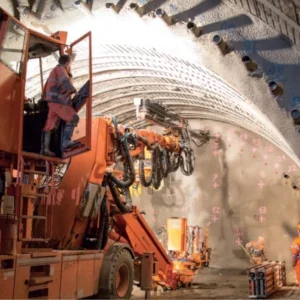Two 20.92m-diameter shafts have been designed to facilitate the upstream surges of the Tehri pumped storage project. Located on the banks of the River Bhagirathi in the state of Uttarakhand, India, the project comprises four reversible pump turbine units of 250MW each and involves the construction of underground caverns and chambers along with the tunnels on the left bank of the Bhagirathi river. The ground is composed of the Lesser Himalayan Phyletic rocks of the Chandpur formation.
Generally 140m deep, the shafts each have a chamber at the top and bottom portion connected to the headrace tunnel. Due to the large diameters, the shafts are planned to be excavated in parts in parallel with the pilot opening. Both shafts are currently under construction and this paper will discuss the support system design, construction method, excavation sequence and construction challenges in the complex geological conditions.
Introduction
The 2400MW Tehri hydropower project is being constructed in three stages. The first two stages of 1,400MW are already in the generation stage, while the third stage of 1,000MW pumped storage is under construction. This fully underground project involves the construction of two upstream surge shafts, butterfly chambers, penstock assembly chambers, vertical penstocks, an underground power house and transformer hall, caverns and twin tailrace tunnels. It is one of India’s rarest underground complexes negotiating as it does with fragile Himalayan rocks to accommodate multiple openings, caverns and vertical shafts.
The two 20.92m-diameter upstream surge shafts are located at the end of the twin headrace tunnels to dampen the water hammer effect which results from the rapid start and closure of the turbine. Separate surge chambers have been provided at the top to facilitate the construction and operation of both shafts.
Geological Setup
The project is situated on the rocks of Chandpur formation of the Lower Himalaya where the main rock units affecting the project belong to Phyllitic Quartzite (PQM, PQM+PQT) and Quartizitic Phyllites (QP, QP+SP). The acronym PQM stands for Massive Phyllitic Quartzite, PQT for thinly foliated Phyllitic Quartzite. The two others, QP and QP+SP stand for Quartizite Phyllities and Sheared Phyllites.
The better and stable ground was experienced with PQM (Type-1), whereas fair rock conditions for tunnelling were found in PQM+PQT (Type-2) zone. The QP and QP+SP (Type-3) and SP (Type-4) categories belong to poor to very poor ground conditions for tunnelling. A geological model of both surge shafts was developed on the basis of subsurface investigations.
Arrangement Of Shaft Layout
The tactical function of the two shafts is to facilitate the upstream surges. The internal diameter 20.92m of the shafts was necessary to facilitate and dampen upstream water surges.
A circular-shape shaft structure was designed for structural stability and hydraulic suitability. A slight rearrangement of the shaft-layout was undertaken away from the initial planning arrangements. This was to ensure they were compatible with the local geology.
Geological Model Of Shaft Design
Assessing geological conditions, i.e the in-situ stress state, is always a crucial task for determining the expected rock behaviour vis-a-vis hydraulic fracturing potential. In order to investigate geological conditions, vertical bore holes parallel to the shaft alignments were drilled. The investigation focused on the identification of various rock units, assessment of permeability, the strength and deformability, as well as orientation and magnitude of the local stress field. Few dilatometer, UCS, triaxial and hydrofracture tests were carried out to confirm the rock-mass strength, deformation modulus and in-situ stresses.
The geotechnical parameters of various rock units were adopted, based on investigation results and empirical correlation.
Shaft Design
A comprehensive series of numerical analyses were performed for the initial support requirement and overall stability of the excavation. Both shafts were designed to stand the test of both global and local stability. To assess the global stability, a stress-deformation analysis was carried out using the 2D FDM programme. The local stability test UNWEDGE revealed that due to different sets of rock joints there was a formation of unstable rock wedges on the site.
Stress deformation led to the discovery that the rock mass surrounding the excavation was homogeneous and isotropic in all directions; the rock mass runs in continuum, and the blast damage zone or disturbance zone comes out to be the first three metres of rock surrounding the excavation. The support installation is carried out after the one-round excavation which generally results in relaxation of stresses up to 90%.
Wedge Stability Analysis
Geometrical and stability analyses of the underground wedges are defined by the intersection of rock mass joints surrounding the shafts, performed on the scale of UNWEDGE software. Four sets of joint planes were selected for wedge formation. Different combinations of all joint sets were analysed. A support system of 350kN with fully-grouted rock bolts, 10m long and at 1.5m centres was adopted to assess the stability of wedges after installation of the support. All wedges were found to be stable with FOS more than 1.5.
Stress Deformation Analysis
For the stress deformation analysis, 2D numerical modelling was carried out using the FLAC programme. A 120m x 120m x 160m model was crested to minimise the influence of the boundaries of excavation. The outer boundaries were kept at sufficient distance from the shafts to simulate ‘far field conditions’.
The support system under analysis consists of composite support, including rock bolts of 350kN tensile strength, and shotcrete with 25MPa compressive strength. Different densities of rock bolts and shotcrete thicknesses were modelled according to the rock type and rock cover. From the analysis it is found that the maximum rate of deformation was found in the weak and high rock cover zone.
Construction Planning
Constructing the two vertical shafts for upstream surges is a huge challenge because of the large diameters involved and the complex geological conditions. Excavation consisted of a raise-climber technique which involved boring a 3m-diameter pilot shaft from the bottom to the top using an Alimak raise climber. The pilot shaft is then widened from the top to the bottom taking into consideration the sequential excavation and support system.
Separate chambers were then constructed at the top of each shaft for widening the pilot shaft and for operational manoeuvres.
To control any shaft deformation and to restrict explosive consumption, taking into account the location of the shafts close to the already operating power house of the THDC, the widening has been modelled as ‘half-face excavation’.
The controlled blast designed was adopted to restrict Peak Particle Velocity and to limit over-excavation of the shafts in the poor rock conditions.
To monitor the behaviour of the excavated face of the shafts, certain geotechnical instrumentation techniques have been proposed. One is the use of multipoint borehole extensometers (MPBX), designed to depict the depth of deformation; another is the rock bolt load shell which monitors the tension on the rock bolt; yet another is the bi-reflex target, proposed to monitor the 3D movement of the shafts’ excavated face.
Excavation and support of the slant portion of the shaft
A series of steps were taken to ensure the stability and effective excavation of the Tehri Pumped Storage Project upstream surge shafts, mainly a crucial slant-portion design, and its excavation and support. The third major step was the casting of collar beams for the erection of truss girders and for movement of the gantry.
Use of equipment for the safe operation of the slant portion
The geometry of the upstream surge shaft and its upper chamber connection was unique owing to the complex geology (low geotechnical properties of rock mass housing the excavation). The shafts’ excavated dimensions just below the chamber (at chamber invert) are 22.52m x15.60m (the dimensions are not rectangular; in plan they comprise two parallel lines separated by 15.6m and their ends are connected by arcs of 11.26m radius). The maximum dimensions of the excavated plan of the upper chambers are 37.52m (L) x15.6m (W). Therefore, the chamber width is restricted to 15.6m, whereas the surge-shaft diameter below it is 20.92m. A change was proposed which was necessitated by the hostile geology and the non-feasibility of the construction of the chamber-size in relation to the surge-tank diameter. Therefore, a circular section of the shaft was tapered to an oval shape at the invert of the upper chamber. A 10m height of shafts was needed for safe operation and optimum use of the equipment. The design process evolved accordingly.
Steps taken to achieve stability of the slant portion of the shaft
The most critical portion of the surge shaft is its slant and 10m-high span below the chamber invert. The chamber was excavated to invert EL.859.50m. Complete levelling concrete was laid at the chamber invert.
The excavation of the slant portion of the surge shafts was undertaken in two semicircular parts. The first part was excavated to EL.854.50m; this allowed the working space (depth) of 2.4m below the bottom chord of the truss girders (gross depth 2.6m). During the downward excavation, the excavation of the collar beam area around the periphery atop the surge shaft was undertaken and stabilised, depending on the type of rock as per the approved GFC drawings. The excavation of the second half was taken up and stabilised accordingly.
Step 1: The initial excavation below the chamber area up to EL. 856.50m, i.e., 3m was achieved in 1m increments with the help of a hydraulic breaker mounted on the excavator. Thereafter up to EL.854.50, excavation was carried out with controlled blasting. The slant portion was worked out using a chiselling method.
Step 2: A first layer of 50mm thick shotcrete was applied and then fixed with the help of a high-strength cable-net, properly securing all the edges (full rock support as per approved drawings has to be provided after every round (1m) of excavation.
Step 3: The final layer of supports was raised. Lattice girders at 0.5m centres slant length were fixed on the first layer of wire mesh.
The second layer of shotcrete was completed. To secure all edges, the second layer of high-strength cable net was fixed, then the final layer of shotcrete applied. Drawing on the final shotcrete surface, rock bolts as per the approved GFC drawing were installed. Until the excavation and support reached EL.854.50m, the measures of step 2 and 3 were followed. Care shall be taken to finish the balance supports in the previous bench, before the next bench round is excavated.
After the completion of excavation and support up to EL.854.50m, the collar beam was cast with reinforcement and the concreting completed around the defined periphery atop the surge shaft. In the process, the provisions of the base plate and bolt arrangement for supporting the truss girder (as per the GFC drawing) were followed, with sufficient time allowed for the collar beams to gain their strength.
Both the truss girders were installed, one by one, at the defined positions. All proper precautions to fix the truss girders were taken. The struts and 20mm-diameter, 1.5m-long rock bolts were fixed as per the drawings.
The excavator was positioned at the chamber invert. Any ramp in to enter the surge shafts was strictly avoided. ln order to maintain the conical shape and to avoid overbreak, careful excavation at the initial stages of the slant portion will be implemented. Blasting was not to be carried out in the initial stage of excavation at least for an initial depth of 3m.
For the remaining slant area, a continued bench excavation was conducted from 5m to 10m depth with each bench-round of 1m depth using soft blasting with line drilling. A chiselling method was used in the slant portion in order to avoid overbreaks and to maintain the shape. Soft blasting was adopted below EL.854.50m in order to give negligible disturbance to the truss girder arrangement. At each stage of work in the excavation of the slant portion, proper platform arrangements were ensured to cover the pilot hole. Any rock fall, cracks or wedge failures were recorded and communicated.
Excavation beyond slant portion
After achieving the construction of the slant portion up to the depth of 10m below the ring beam, we could achieve the required circular diameter of 20.92m and began the shaft sinking in full swing. We achieved a consistent progress of 6m/ month in each shaft. Presently, we are proceeding with drilling and blasting with 2m advances per cycle, followed by mucking, fixing of lattice girders @ 1.5m centres, wire-mesh fixing, two layers of shotcreting and fixing of 62 x 10m-long grouted rock bolts.
Conclusion
The construction of a surge shaft is the most critical phase of a hydro power project as it involves multiple stages for completion. It becomes even more critical when adverse geology is encountered.
Therefore, proper planning based on sound design is very important for a safe and stable construction.
Due to the variety of geological conditions and the large diameter of the shafts, it is proposed that shafts should be constructed using NATM. The complete sequence of excavation was modelled using the finite element model to ascertain that an adequate safety factor is obtained for stresses in the final lining.
Based on the project’s detailed geological and geotechnical data, the shaft profile has been divided into three segments of similar rock types, where similar ground support can be applied. Excavation and initial ground support systems have been designed for each of the segments. The excavation options include dividing the shaft profile in two parts based on restricted ground vibration and controlled overbreak.
Both shafts were constructed to the 28% depth using sequential excavation and the designed support measures. The excavated zone has been constantly monitored using geotechnical instrumentation: it was found that both shafts have been performing perfectly as per the designed assumptions.






